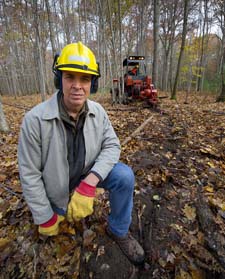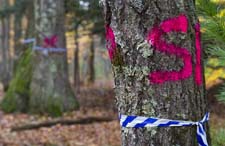Michigan DNR and U.S. Forest Service partner to protect oak trees from killer fungus
Michigan Department of Natural Resources sent this bulletin at 12/04/2014 02:14 PM EST|
Your weekly Showcasing the DNR feature story and photos |
 |
 |
 |
 |
 |
Showcasing the DNR
Michigan DNR and U.S. Forest Service partner to protect oak trees from killer fungus
Like American elm in the 1950s and ash trees in more recent history, Michigan’s red oak trees are facing potentially significant die-offs due to an exotic and largely invisible killer: oak wilt.
A deadly fungus that can kill previously healthy trees within a matter of weeks, oak wilt is spread by sap-feeding beetles – also known as “picnic beetles” – that introduce the disease to freshly wounded trees. The fungus then quickly moves through the underground root systems that connect entire stands of oak trees, rapidly increasing the impact of one infected tree.
“Oak wilt kills by interfering with the vessels that transport water throughout the tree,” said Roger Mech, forest health specialist for the Michigan Department of Natural Resources’ Forest Resources Division. “The fungus plugs up those vessels and is fatal; if a red oak tree is exposed to oak wilt spores, they are going to kill the tree.
“It just floors me how quickly it happens. It’s dramatic.”
Trees with oak wilt commonly begin dying from the top down, since the top is farthest from the roots and is the first part of the tree to suffer from lack of water. Red oaks shedding their leaves in June or July instead of during the late fall can be a sign of an oak wilt infection.
Although experts do not predict the loss of red oaks in Michigan will be on the same scale as ash trees lost to the emerald ash borer, the impact will still be significant in terms of losing forested areas that provide recreation, critical wildlife habitat and valuable timber.
“In our state parks and recreation areas in particular, it has become a huge issue,” said Heidi Frei, stewardship coordinator for the DNR’s Parks and Recreation Division. “P.J. Hoffmaster State Park is one example where more than 140 mature red oaks have been lost, resulting in a near clear-cut of the campground area.”
Many state parks, recreation areas, state forest campgrounds and other areas of state-managed land have been impacted by oak wilt, with the disease now widespread across much of the Lower Peninsula and parts of the southern Upper Peninsula. Unfortunately, once oak wilt is present it is nearly impossible to entirely eradicate, but opportunities have been identified to help slow the spread of the disease.
Unfortunately, once oak wilt is present it is nearly impossible to entirely eradicate, but opportunities have been identified to help slow the spread of the disease.
“All signs point to the movement of firewood as a major culprit in the rapid spread of oak wilt,” Frei said, noting that when oak wilt is detected in a park or recreation area, it is typically first found in or near the campgrounds, where trees with vehicle- or camper-inflicted damage are especially vulnerable to infection from contaminated firewood.
“Cooperation from the public in using locally sourced firewood rather than transporting it will be critical in helping to protect valuable urban landscapes and rural forests from the devastating impacts of oak wilt disease and other forest diseases and pests, like the emerald ash borer,” Frei said.
Landowners are also advised to not prune oak trees between April 15 and July 15, when the beetles that spread the fungus take advantage of trees with fresh wounds to feed on sap. Planting trees that are resistant to oak wilt is also recommended.
Trees in the in the red oak group – those that have pointy-lobed leaves, such as northern red oak, black oak and pin oak– are most susceptible to the disease, Mech said. White oaks – those with rounded lobes – are much less susceptible, though they occasionally are also infected.
“We tell folks that if they’re looking to reduce the risk of losing entire stands of trees to oak wilt, increasing diversity in their landscaping and forested land is ideal,” Mech said. “If they want to plant oak trees, white oak is the best option.”
In addition to these preemptive means of preventing or slowing the spread of oak wilt, the DNR’s Forest Resources and Parks and Recreation divisions have partnered with the U.S. Forest Service to develop and implement a method of treating stands of oak trees that are already infected.
The new cooperative effort between the DNR and USFS focuses specifically on stopping the spread of oak wilt through underground root systems by identifying stands of infected trees and then using specialized equipment to create narrow trenches between the trees, separating the root systems.
identifying stands of infected trees and then using specialized equipment to create narrow trenches between the trees, separating the root systems.
“We use a vibratory plow – equipment typically used for laying cable – and cut roots to a depth of 5 feet,” Mech said. “The DNR’s Forest Fire Experiment Station in Roscommon designed and built special blades to reach a sufficient depth to literally slice the roots, establishing a barrier between the infected and uninfected trees.”
Considering the highly contagious nature of oak wilt and the fact that root systems of large oak trees can spread 60 feet or more, all red oaks found within the trenched area must be removed for the treatment to be effective.
The removed trees are cut and chipped, burned, or sawed into lumber to help prevent any potential overland spread of oak wilt spores.
In 2014, the plow treatments were completed on state forest land in Alpena, Benzie, Charlevoix, Grand Traverse, Missaukee, Otsego and Roscommon counties, and national forest land in Iosco, Manistee and Wexford counties. Additional work will continue in 2015.
Although the trenching method works well in forested areas, Mech said there are challenges to using it in urban or residential areas.
“In some cases, the plow can’t be used due to buried utilities, septic and sewer lines, small lot sizes and other limitations,” Mech said. “This method is effective where we can use it, but it isn’t a fail-safe. Response treatments have their limitations.”
“Long-term success in combating the spread of this devastating forest disease will depend heavily on the public’s support for taking the necessary proactive measures. The two approaches go hand-in-hand.”
To learn more about preventing the spread of oak wilt disease in Michigan, visit www.michigan.gov/foresthealth.
###
NOTE TO EDITORS: Photos to accompany this story are available for download at http://www.michigandnr.com/ftp/outreach/ in the folder marked “Oak Wilt Disease” (Michigan DNR photos)
Captions:
DSK502 107: DNR forest technician Phillip Kurzeja checks under the bark of a red oak, looking for indications of oak wilt disease.
DSK502 126: Sap-feeding “picnic beetles” spread the oak wilt fungus to trees with fresh wounds.
DSK502 136: A stand of infected trees are marked for treatment, which involves using a specialized plow to sever underground root systems to separate infected and uninfected stands of oak.
DSK502 139: The vibratory plow blade used to treat infected stands of oak was specially designed and built at the DNR’s Forest Fire Experiment Station in Roscommon. The plow cuts narrow trenches 5 feet deep to separate underground root systems, preventing further spread of the oak wilt fungus to uninfected trees.
DSK502 162: DNR forest health specialist Roger Mech places his boot into the narrow trench created by the vibratory plow, which is designed to minimally disturb the surface while cutting deep into the ground to separate vast oak tree root systems.
Thank you for your interest in Showcasing the DNR. See past editions at www.michigan.gov/dnr-stories. Questions or comments? Please contact DNR deputy public information officer Debbie Munson Badini at 906-226-1352 or badinid@michigan.gov.